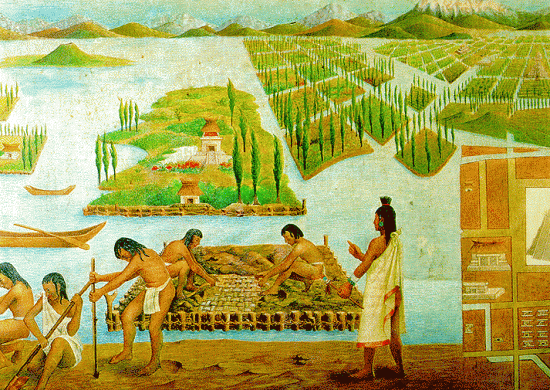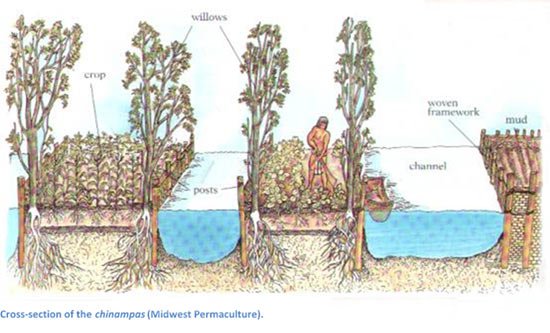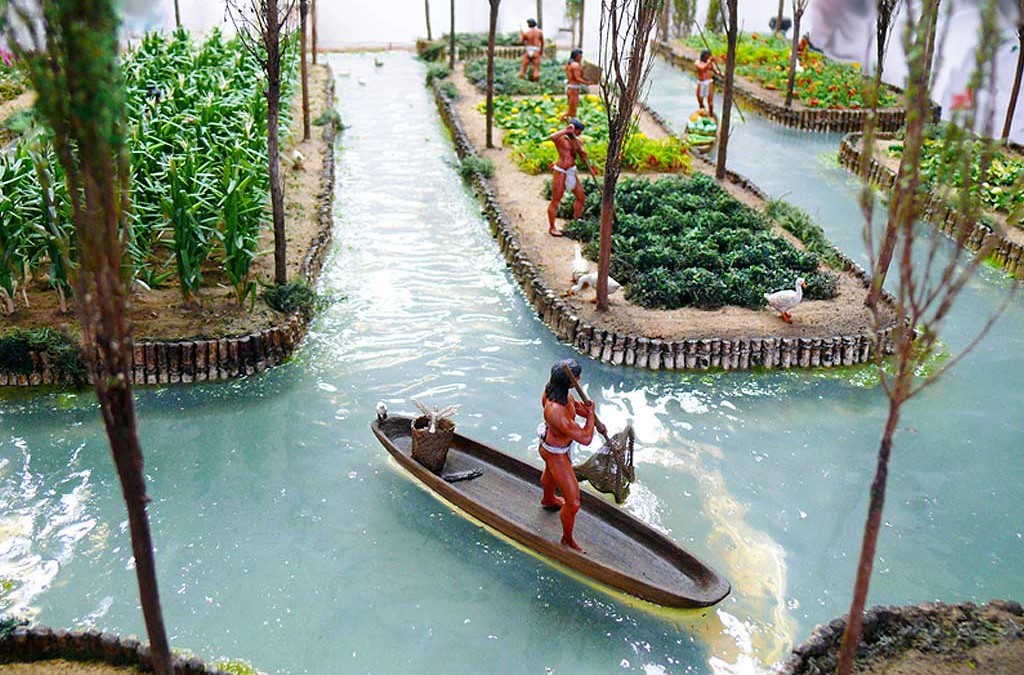How To Become More Self-Sufficient Without Starting a Full-Blown Farm…
Want to start preserving your harvest, making your own soap, or building a backyard root cellar — but not sure where to begin? “Homesteading Advice” gives you instant lifetime access to 35+ practical homesteading books on food preservation, veggie gardening, DIY natural cleaning products (save over $250 per year with this skill alone), brewing, off-grid energy, and a whole lot more…
Click Here To Check It Out Now!
You may be skeptical about how a civilization could create flourishing gardens on a lake, but the Aztecs achieved just that with their ingenious floating gardens.
Picture yourself standing on the shores of Lake Texcoco, marveling at the sight of man-made islands floating on the water’s surface.
The Aztecs, driven by their resourcefulness, constructed these gardens using rafts made of woven sticks and soil piled on top. The rectangular shape of these gardens allowed for efficient use of space, resulting in an impressive seven crops per year.
However, the fate of these remarkable gardens took a tragic turn with the arrival of the conquistadors.
Curious to know more about the construction, engineering marvels, religious significance, and ultimately, the heartbreaking destruction of the floating gardens? Join us on this captivating journey.
Gardens Floating On Water
- The Aztecs built chinampas, or floating gardens, on Lake Texcoco as a way to convert wetlands into farmland.
- The construction of the gardens involved weaving sticks together to create a raft and piling mud on top to form soil.
- The gardens were a masterpiece of engineering, with a rectangular shape that allowed for efficient use of space.
- The floating gardens were destroyed by the conquistadors, driven by their desire for gold, leading to the loss of a significant aspect of Aztec civilization.

Construction and Features
The construction and features of the floating gardens, known as chinampas, were a remarkable engineering achievement by the Aztecs. These gardens were built on Lake Texcoco to convert wetlands into productive farmland.
The Aztecs used ingenious chinampa construction techniques to create these gardens. They’d weave sticks together to form a sturdy raft and then pile mud on top to create soil. Willow trees were strategically planted at the corners to anchor the gardens. Canals surrounded the gardens, providing transportation and irrigation.
The benefits of chinampa agriculture were immense.
These gardens covered a vast area of 22,000 acres and yielded seven crops per year. The rectangular shape of the gardens allowed for efficient use of space, maximizing agricultural output. Each garden was 300 feet long by 30 feet wide. The Aztecs were able to sustain their growing population through the productivity of the chinampas, making it a crucial aspect of their civilization.
‘Did You Know? The chinampas were so successful that some are still in use today in Mexico, continuing the ancient tradition of sustainable farming.’
Engineering Marvels

The sustainability of the chinampas was a testament to the Aztec ingenuity and their deep understanding of the natural environment. By converting wetlands into farmland, the Aztecs maximized the use of available resources and created a highly efficient system of food production.
The impact of the floating gardens on the Aztec civilization was immense. The gardens covered a vast area of 22,000 acres, yielding seven crops per year. The gardens were companion planted with corn, beans, squash, tomatoes, peppers, and flowers. This abundance of food sustained a growing population and fueled the development of a complex society.
The rectangular shape of the gardens allowed for efficient use of space, while the canals provided transportation and irrigation. The engineering marvels of the floating gardens not only provided sustenance but also contributed to the flourishing of the Aztec civilization.
Aztec Sacrifices and Religion

Did the Aztec religion and sacrificial practices have a direct connection to the floating gardens?
The answer is yes.
The Aztec society believed that sacrifices were crucial for the success of their agricultural endeavors. Sacrificial victims, perched atop the temple pyramid, could see the floating gardens in all their glory. The act of sacrificing was performed to please the gods and ensure the prosperity of the gardens.
The sight of tens of thousands of heads rolling down the temple steps was a symbol of devotion and a plea to the gods for fertile gardens. The rivers turning red during these rituals further emphasized their connection to the gardens, as it represented the Aztecs’ desire for abundance.
Thus, the Aztec religion and sacrificial practices had a significant impact on Aztec society and played a crucial role in the success of the floating gardens.
Destruction by the Conquistadors
The Conquistadors, armed with their superior military power, were determined to obliterate the floating gardens of the Aztecs, dealing a devastating blow to the core of their civilization. The impact of this destruction on Aztec society was profound, as these gardens held immense cultural significance. Not only were they a vital source of sustenance, but they also represented the Aztec’s remarkable engineering skills and their deep connection to nature.

The Conquistadors’ destruction not only disrupted the Aztec’s agricultural system but also severed their ties to their ancestral lands. This loss extended far beyond physical structures; it encompassed their identity, community, and traditions. The destruction of the floating gardens marked the beginning of the end for the Aztec civilization, stripping them of their means of survival and severing their connection to their cultural heritage.
Like Much Of History…
The breathtaking floating gardens of the Aztecs were a testament to their ingenuity and resourcefulness. These man-made islands transformed the vast lake into a thriving agricultural wonderland, producing an astonishing seven crops per year.
Unfortunately, the tragic arrival of the conquistadors led to the heartbreaking destruction of these marvels. Like a fragile dream shattered by reality, the floating gardens became a symbol of the devastating impact of colonization on indigenous civilizations.

